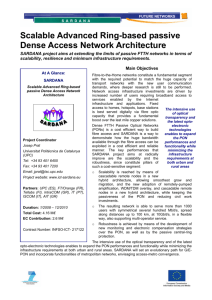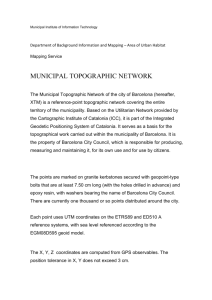Sardana
advertisement
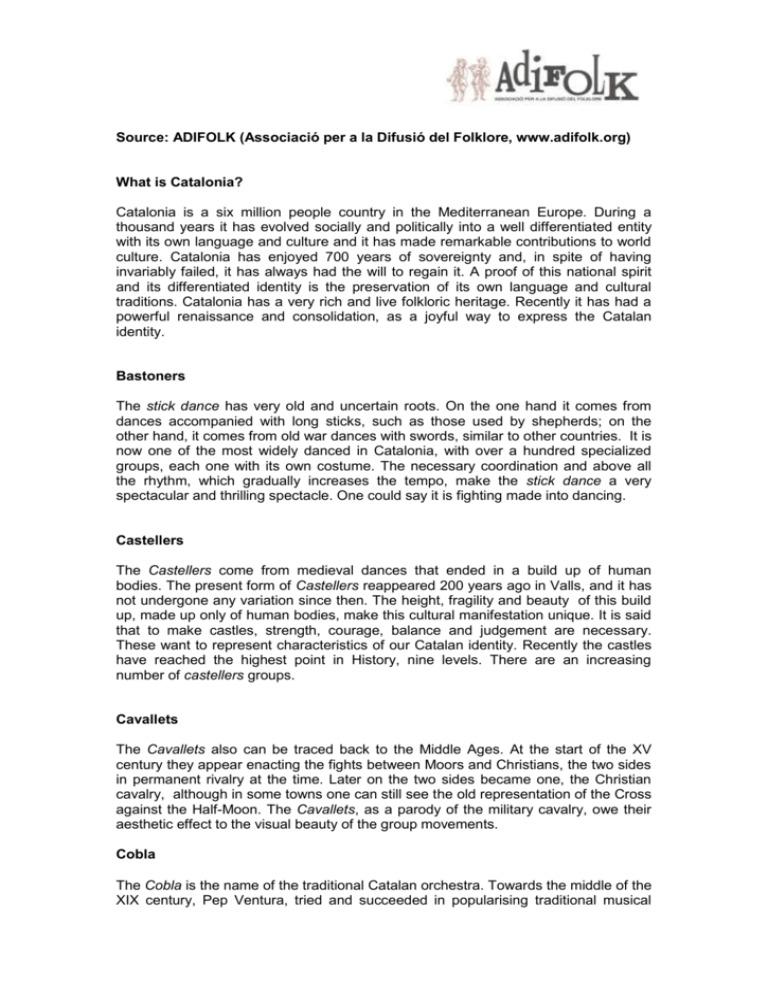
Source: ADIFOLK (Associació per a la Difusió del Folklore, www.adifolk.org) What is Catalonia? Catalonia is a six million people country in the Mediterranean Europe. During a thousand years it has evolved socially and politically into a well differentiated entity with its own language and culture and it has made remarkable contributions to world culture. Catalonia has enjoyed 700 years of sovereignty and, in spite of having invariably failed, it has always had the will to regain it. A proof of this national spirit and its differentiated identity is the preservation of its own language and cultural traditions. Catalonia has a very rich and live folkloric heritage. Recently it has had a powerful renaissance and consolidation, as a joyful way to express the Catalan identity. Bastoners The stick dance has very old and uncertain roots. On the one hand it comes from dances accompanied with long sticks, such as those used by shepherds; on the other hand, it comes from old war dances with swords, similar to other countries. It is now one of the most widely danced in Catalonia, with over a hundred specialized groups, each one with its own costume. The necessary coordination and above all the rhythm, which gradually increases the tempo, make the stick dance a very spectacular and thrilling spectacle. One could say it is fighting made into dancing. Castellers The Castellers come from medieval dances that ended in a build up of human bodies. The present form of Castellers reappeared 200 years ago in Valls, and it has not undergone any variation since then. The height, fragility and beauty of this build up, made up only of human bodies, make this cultural manifestation unique. It is said that to make castles, strength, courage, balance and judgement are necessary. These want to represent characteristics of our Catalan identity. Recently the castles have reached the highest point in History, nine levels. There are an increasing number of castellers groups. Cavallets The Cavallets also can be traced back to the Middle Ages. At the start of the XV century they appear enacting the fights between Moors and Christians, the two sides in permanent rivalry at the time. Later on the two sides became one, the Christian cavalry, although in some towns one can still see the old representation of the Cross against the Half-Moon. The Cavallets, as a parody of the military cavalry, owe their aesthetic effect to the visual beauty of the group movements. Cobla The Cobla is the name of the traditional Catalan orchestra. Towards the middle of the XIX century, Pep Ventura, tried and succeeded in popularising traditional musical compositions by creating the cobla, adding new instruments designed by Andreu Toron from the Roussillon. Nowadays the Cobla is made up of eleven musicians, a recorder and drum played by the same musician, two tiples and two tenoras – an instrument related to the oboe, which produces the characteristic sound of the cobla , two trumpets, a basson, two fiscornos and a double bass. The Cobla, which was born with the Sardana, not only provides the music for this dance, but also allows even a classical repertoire being performed but with a distinct and local musical character. Colles sardanistes (sardana groups) The competitive Colles sardanistes started in the XX century, when the sardana becomes very popular. The sardana requires a precise awareness of rhythm in order to be danced properly. Gradually it became the national dance of Catalonia. The sardana competitions are very well established. The Colles, made up of six couples, competing among themselves in order to see who dances more in harmony as a group. Diablos (devils) The devils have their origins in old religious representations of the fight between good and evil. These representations were part of the Corpus Cristi processions. The first documented occasion of the devils is a royal wedding in the XVI century. In some towns, the diablos, as well as moving in response to the fire, they recite some satiric verses, criticising the authorities and current political issues. The return to democracy has meant to recover the street as performance space. The diablos have become a regular performance in all festivals throughout Catalonia. At night, the fire as an essential element, as a fantastic component which makes the diablos into something unreal and yet very participative. Dragones (dragons) The dragones are present in all mythologies and legends. They are extraordinary animals which inspire ancestral fears. They tend to have ferocious mouths, serpent scales and vat-like wings. They touch the common fears of the collective unconscious. The dragon, as other mythological figures, forms part of the medieval processions of Corpus Cristi, as a detente to prevent evil. Gradually the physical attraction came to dominate the religious significance, becoming almost exclusively a symbol of the fiesta. Its salience, above other elements of the popular mythology, may be explained by the legend of the dragon being killed by Saint Jordi, patron of Catalonia. Esbarts The Esbarts are amateur groups that work on shows of traditional Catalan dancing. They were formed at the beginning of the XX century to ensure the preservation of the rich musical heritage. Since then they have systematically worked and preserved the Catalan dancing heritage. The Esbarts, with their beautiful performances, are an integral part of our cultural heritage. Falcons The Falcons are relatively new in Catalonia. A mixture of gymnastics and popular dancing, it comes from Chec groups, called Sokols. The first groups of Falcons are formed in the nineteen thirties, introduced by the Federation of Young Christians, who had links with Checoslovaquia. After the Civil War, towards the fifties, it is taken up again by the Youth Association for Catholic Action. It becomes increasingly popular, particularly in the region of Gran Penedès. The Falcons has similarities to the castle build-ups and it also has a strong gymnastic component. Gegants (giants) The presence of gegants in the Catalan fiestas can be traced back to the XIV century and has continued to the present day. Initially, similarly to the rest of Europe, the gegants were part of the Corpus Cristi processions, and they evoked biblical characters. Gradually they lost their religious origins and became an essential part of the profane celebrations. Now the Gegants are not only cardboard figures that march on the streets, but they also perform increasingly complex choreographies. They embody historical and legendary local characters, becoming powerful symbols of local identity. To see the Gegants in the streets means that the fiesta has started. Grallers The gralla is a traditional wind instrument which produces a strident sound of a primitive character. It has acquired an increasing popularity in the last twenty years. The groups of grallers are made up of two or three gralles accompanied with a drum. Like many other traditional cane instruments, it nearly disappeared. It was only present when building castles. With the recovery of popular culture, the gralla went beyond the castle background and became the usual instrument played with the bastoneros, gigantes and other groups of popular culture. Traditional music In Catalonia, root music performed with local instruments is not an isolated and occasional event. It forms part of an ever growing popular movement. The recovery, and even new manifestations, of old melodies is carried out by many groups that take their performance to the streets, as part of a folk festival or in a dancing or concert session. Thus a great number of old instruments have been saved – many forgotten until recently – and old compositions. When the old instruments play along the new ones, the resulting sound has a very Catalan character. These groups have managed to transform the traditional music from an object of study to a live one. Sardana The Sardana is a dance performed in a circle which has become the national dance of Catalonia. It has evolved from an old dance known sardana corta. In the middle of the XIX century , the musician Pep Ventura and the dancer Miquel Pardas introduced some changes which have remained until today. At the same time that the Sardana was changed, the present cobla was also created. From the Girona region the sardana spread throughout Catalonia. Nowadays is performed by many groups and associations in streets and squares all over Catalonia and the South of France. The Sardana invites everybody to join the circle and dance.
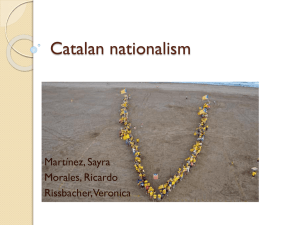
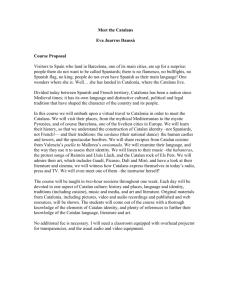
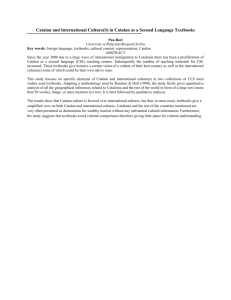

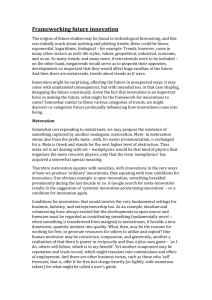
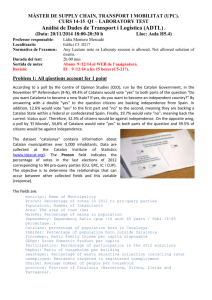
![catalonia background information [series e / 2013 / 8.1 / en]](http://s3.studylib.net/store/data/008093211_1-d72fdeba08068076ca11c1ebc12261a0-300x300.png)
